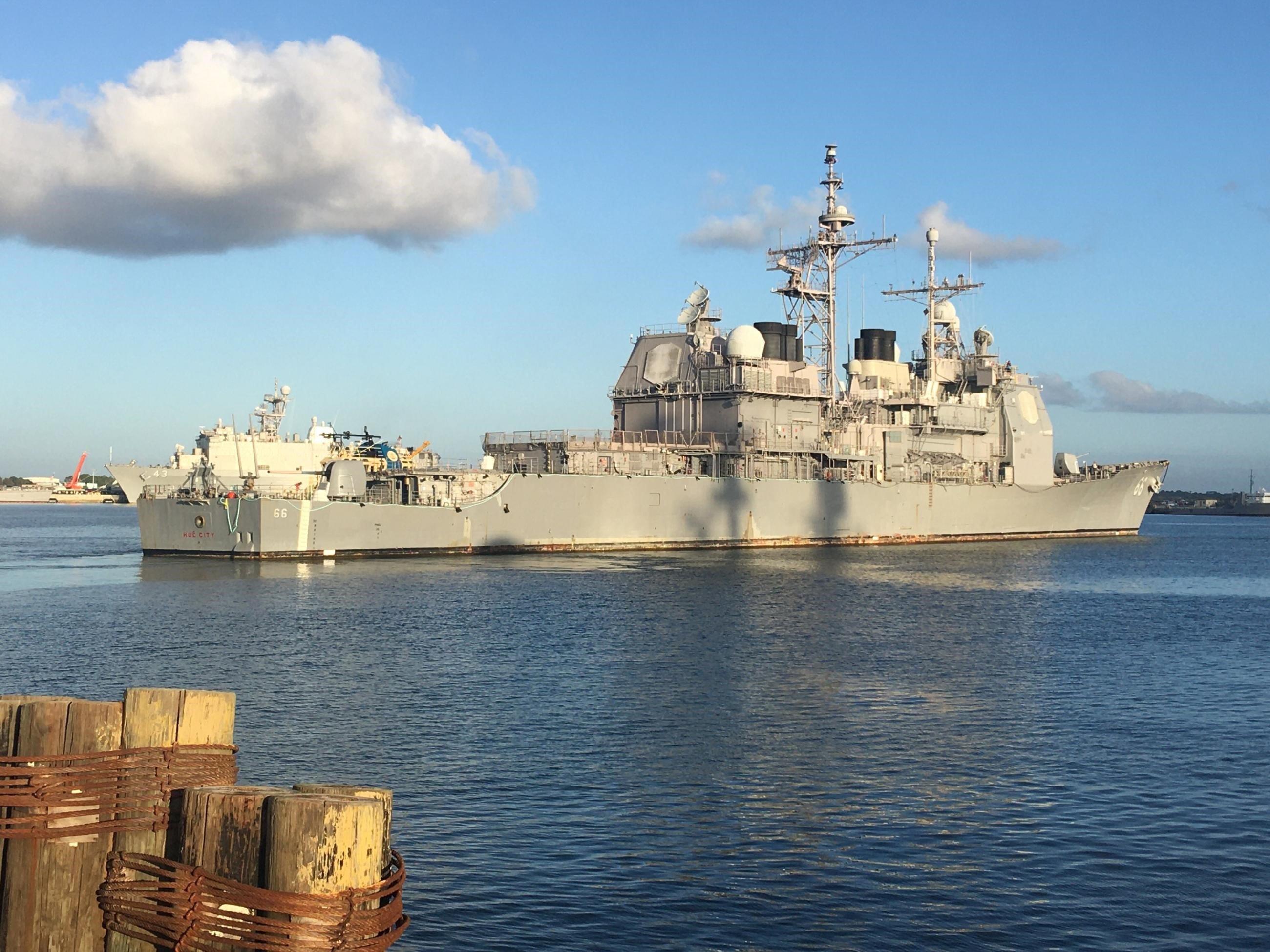
The Navy’s push to retire seven guided-missile cruisers stems from management and planning in its original modernization program that caused exorbitant cost growth, according to service officials.
Navy officials have repeatedly cited cost as a reason for the proposed decommissionings, arguing that the service could put the money toward other modernization priorities instead of sustaining the aging platforms.
“The cruisers right now and the modernization are running 175 to 200 percent above estimated costs, hundreds of days delay. These ships were intended to have a 30-year service life, we’re out to 35,” Chief of Naval Operations Adm. Mike Gilday told the House Armed Services Committee last month.
Reasons for the cost increases range from contractor performance to planning problems plaguing the modernization effort, a spokesperson for Naval Sea Systems Command told USNI News this week.
“Since the CG Mod program’s inception in 2015, there have been issues with planning and execution. These issues have included: contract award values significantly exceeding Independent Government Estimates; late delivery of Government Furnished Material for early ships in the program; and limited learning between successive availabilities due to awards being made across multiple contracts and time periods,” NAVSEA spokeperson Jamie Koehler told USNI News. “During execution, cost growth can be attributed to program complexity: ships had sat idle for five to six years prior to entering the repair yard, contributing to an underestimation of pre-existing ship conditions, underestimation of the challenges in system reactivation after prolonged inactivity, and poor industry performance.”
The Navy is seeking to retire seven cruisers – USS San Jacinto (CG-56), USS Lake Champlain (CG-57), USS Monterey (CG-61), USS Port Royal (CG-73), USS Vella Gulf (CG-72), USS Hué City (CG-66) and USS Anzio (CG-68) – in its Fiscal Year 2022 budget request. Keeping those seven cruisers in the fleet would cost the service about $5 billion throughout the Pentagon’s five-year budget outlook, deputy chief of naval operations for warfighting requirements and capabilities (OPNAV N9) Vice Adm. Jim Kilby told Congress last month.
“If we were to retain those ships for two years – all seven ships – that’s roughly $2.78 billion. The cost to modernize Hue City and Anzio alone is $1.5 billion approximately,” he said. “So that’s the rough breakdown of figures for those ships.”
In addition to the cost of maintaining the cruisers, the Navy issued contracts for the cruiser modernization initiative that were more than the government’s projections, according to Koehler.
“The budgets originally established were created from Independent Government Estimates (IGEs) that are based off historical cost, RMC, Third Party Planner, and Planning Yard inputs,” Koehler said. “The fixed-price contracts that were subsequently awarded following negotiations significantly exceeded the IGE and were awarded post-budget submission and therefore are not reflected in budget books. The awarded contract values for Cruiser Modernization availabilities were announced via press release at time of award.”
Seeking to justify the Navy’s proposal to decommission the warships, Kilby cited fuel tank leaks that have repeatedly plagued the aging cruisers.
“She missed roughly one-third of the deployment because of maintenance things, not because her radar was down, not because her combat system wasn’t capable, not because she didn’t have a full magazine – but she had tank top cracking that required her to get that fixed to be safely underway,” Kilby told HASC last month, referring to a 2017 deployment for Lake Champlain.
“Vella Gulf missed a month of her previous deployment and has missed two and a half months of her current deployment. So all that, in my mind, has to go into the mix when we factor the availability and reliability of those ships. Those missile tubes will only count if they’re underway alongside the carrier,” he added, referring to Vella Gulf, which had to return to port for the first two months of its recent deployment due to maintenance issues that included fuel tank leaks.
While the Navy wants to retire the seven ships in FY 2022, some lawmakers have criticized the move and are skeptical of the service’s overall divest-to-invest approach to the budget.
Rep. Elaine Luria (D-Va.), a former nuclear-qualified surface warfare officer who once served as the executive officer of Anzio, has openly opposed decommissioning the cruisers.
“I’ll continue to say what I have: it’s a ship that we have, and the cost of modernizing and upgrading it for extending its service life 10 or so years is significantly lower than building a new ship,” Luria told USNI News in an interview earlier this year, adding that “the amount of time it takes to build a new ship, we just can’t decommission 10 cruisers faster than we can build replacements.”
“We have a real and proximate threat from China in the Western Pacific, South China Sea, East China Sea. We need to be present, and we need the capabilities that a cruiser brings, including its VLS cells. So the idea that the Navy’s longer-range plan in this Battle Force 2045 is to replace cruisers – who have two full [Vertical Launching System] launchers, over 120 cells – with a fleet of these Large Unmanned Surface Vessels with 16 VLS cells, a technology that’s not mature,” is not a move she would back.





